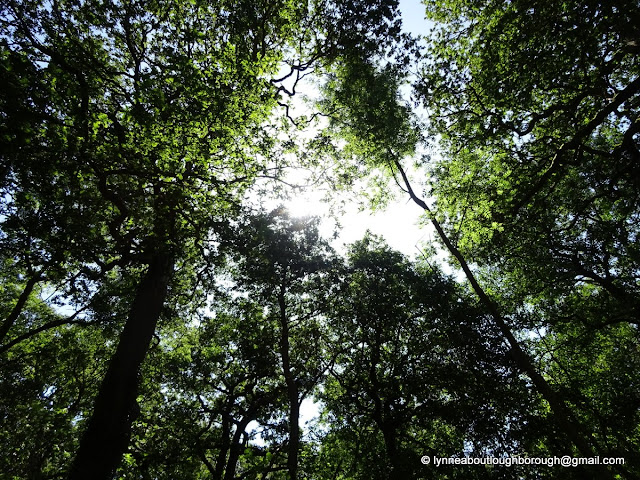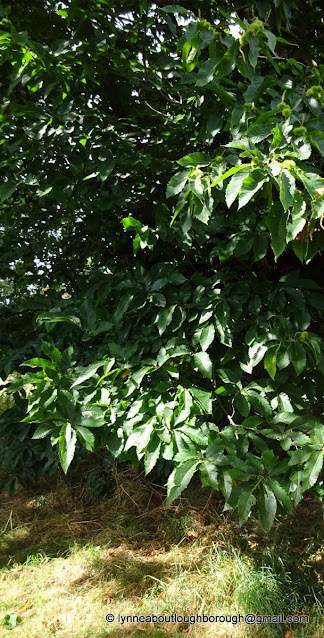In previous years, several Loughborough venues have taken part in the national Heritage Open Days (HODs) event, throwing open their grounds, doors, and towers for free to visitors.
This year, a number of building owners, organisations, and groups got together to plan a more extensive event over the final weekend of the HODs event, which has resulted in over a dozen opportunities for you to visit some of Loughborough’s buildings, take part in roadshows and workshops, or go on a walk around the town!
Loughborough’s Heritage Open Weekend takes place on Saturday 14th and Sunday 15th September.
Why not come along to one of the four walks that are being offered by the Loughborough Library Local Studies Volunteer Group? More details of these walks are below, and details of other events taking place over the weekend will appear on this blog next Sunday!
The Loughborough Suffragette Trail
Walk Leader: Yvonne Casswell
Date: Saturday 14th September, 10.00-11.30
As part of Loughborough’s Heritage weekend in September there will be a trail following the steps of the suffragette movement in the town. Many people will know of the Pankhurst family setting up the Women’s Social and Political Union (WSPU) in 1903 and of Alice Hawkins’ activities in Leicester. The Loughborough Branch of the WSPU was founded in 1909. Meetings were held at the Town Hall and outdoors in the Market Place. The latter were often rowdy affairs with local activists and visiting speakers subjected to heckling, jeering and being pelted with orange peel and eggs. Familiar names such as Emmeline Pankhurst, Alice Hawkins and Annie and Nellie Kenney were among those activists who visited Loughborough to promote the cause and inspire local supporters.
In Loughborough Kathleen and Nora Corcoran are remembered for their work for the women’s suffrage cause in the last few years leading up to the outbreak of war in 1914. In 1910 controversy arose as the local Liberal M.P., Sir Maurice Levy had not supported women’s suffrage in the absence of full male suffrage. Meetings in this year when there were elections in January and December were particularly noisy and rowdy and the police were needed to escort the women to safety.
The scene of the only “outrage” by suffragettes took place in the Red House on Burton Walks in October 1913. Find out why this property, empty at the time, was targeted. Pamphlets about Emily Davison and her attempt to stop the King’s horse were found there. The ‘Loughborough Echo’ reported that although the incident aroused anti-suffragette feelings locally, people blamed outsiders rather than local ladies. Local newspapers and quotes from politicians reflected the misogyny of the period.
Also in 1913 the Corcoran sisters were active in the Women’s Tax Resistance League and refused to pay their house duty. An auction was held by a tax collector to raise money to clear the debt.
 |
| The Leicestershire County Council Green Plaque unveiled in 2019 |
The trail was created by the Loughborough Library Local Studies Volunteers based on a publication by Mike Shuker for Leicestershire Labour History Society [1].
Yvonne Casswell
The Zeppelin Raid
Walk Leader: David Kirkby
Date: Saturday 14th September, 14.00-15.30
On the night of January 31st 1916, Loughborough was bombed by a Zeppelin of the German Naval Airship Division, ten people were killed and twelve others injured with the majority needing treatment at Loughborough Hospital, on Baxter Gate.
But, why was Loughborough a target, where were the bombs dropped, who
were the casualties and who were the heroes?
On Saturday September 14th all will be revealed, following an insight into what Loughborough was like at this period of World War One we follow the path of the Zeppelin, from Queen’s Park to Empress Road, that brought so much devastation and sorrow to Loughborough.
We look at the bomb sites and we reflect on the casualties. We also look at the importance and significance of major buildings in the town at the time.
 |
| Memorial in The Rushes |
Recognised on the day will be those locals who put their own lives at risk for the sake of others.
David Kirkby
Loughborough’s Art Deco Buildings
Walk Leader: Lynne Dyer
Date: Sunday 15th September, 10.00-11.30
While you’ve been out and about around Loughborough town centre, have you noticed some of its beautiful Art Deco buildings? Loughborough is no Miami or Napier, but it does have some lovely examples of buildings designed during the period when Art Deco was fashionable.
On this walk around Loughborough, you’ll see some of these buildings for yourself, hear about some of the style’s key features, and come to understand perhaps why there are so many of these buildings in the town centre.
 |
| A wonderful example of an Art Deco building! |
Why not come along on this guided walk, and discover some of Loughborough’s Art Deco treasures, hidden in plain sight?!
Loughborough’s Heritage Sites
Walk Leader: Lynne Dyer
Date: Sunday 15th September, 14.00-15.30
During Heritage Open Days 2024, some of Loughborough’s marvellous buildings have been open for you to visit and enjoy over the weekend. Don’t worry if you’ve missed seeing them this year, as this afternoon walk will showcase many of them, so you will be able to at least view them from pavement, and hear a little bit of their history.
Although it won’t be possible to walk to all of the buildings which have been open this weekend, as they are spread right across the town, those that are central to Loughborough town centre will be included.
 |
| Courtesy of the Loughborough Library Volunteer Group |
Do please come along on this walk and help to make Loughborough’s Heritage Open Weekend a success! National Heritage Open Days is an annual event, so the more people who support Loughborough’s offering this year, the more likely it is to be repeated next year!
____________________________________
NOTES
[1] Shuker, Mike (2018). Suffragettes in Loughborough. IN: Leicestershire Labour History Society Journal, Vol.1, No.2 [Online] Available from: https://issuu.com/charnwoodarts/docs/suffragettes_in_loughborough_pamphl
____________________________________
Further Resources
Some of the UK’s most spectacular Art Deco buildings
captured on postcards
https://www.francisfrith.com/uk/blog/art-deco-architecture-in-britain
Some of the most exciting Art Deco buildings to visit in
London
https://www.londonxlondon.com/art-deco-buildings-london/
Guided tours of Nottingham’s Art Deco buildings
https://www.eventbrite.co.uk/cc/deco-in-the-details-3590719
____________________________________
About Yvonne
Yvonne has lived in Loughborough for five years. She was born and brought up in S. Wales, and came to Leicestershire to study at Leicester University. She married, and she and her husband have two grown up children. She spent some time working in education. After retiring Yvonne volunteered as a cottage guide at Stoneywell, a nearby National Trust property. More recently, she has volunteered with the Loughborough Library Local Studies Volunteer Group.
About David Kirkby (MInstLM, MSET, LCGI, MGB)
Born in Leicester but lived for the majority of his life in Loughborough.
Educated at Shelthorpe School, Garendon High School, Burleigh Community College, Loughborough College, Leicester College, Derby College and De Montfort University.
Bricklayer by trade, time served Apprentice at H. Hammond and Sons Ltd. & Journeyman Bricklayer for William Moss and Sons.
Former Lecturer in Construction at Leicester College, Derby College & Brooksby College.
Former Head of Construction at Derby College, Fern Training & Brooksby College.
Member of the Loughborough Library Local Studies Volunteer Group with a passion for history, locally, nationally, internationally, & family.
About
Lynne
Lynne trained as an accredited Leicestershire Tour Guide in 2013, and has been leading guided walks around Loughborough since that time. She also writes books and gives presentations about Loughborough, and is the main writer for this blog.
____________________________________
Please note, the views expressed in this Guest Blog Post are the views of the author, and do not necessarily reflect the views of the blog owner, lynneaboutloughborough.
____________________________________
Posted by lynneaboutloughborough
With apologies for
typos which are all mine!
_______________________________________________
Thank you for reading this blog.
Copyright:
The copyright © of all content on this blog rests with me, or in the case of guest blogposts, with the named Guest Blogger. However, you are welcome to quote passages from any of my posts, with appropriate credit. The correct citation for this looks as follows:
Dyer, Lynne (ed.) (2024). Loughborough Heritage Open Weekend Walks. Available from: https://lynneaboutloughborough.blogspot.com/2024/08/loughborough-heritage-open-weekend-walks.html [Accessed 25 August 2024]
Take down
policy:
I post no pictures that are not my own, unless I have express permission so to do. All text is my own, and not copied from any other information sources, printed or electronic, unless identified and credited as such. If you find I have posted something in contravention of these statements, or if there are photographs of you which you would prefer not to be here, please contact me at the address listed on the About Me page, and I will remove these.
Blog
archive and tags:
If you are viewing this blog in mobile format, you will not be able to easily access the blog archive, or the clickable links to various topics. These can be accessed if you scroll to the bottom of the page, and click 'View Web Version'. Alternatively, there is also a complete list of posts, which when clicked will take you to the page you are interested in.
Searching
the blog:
You can search the blog using the dedicated search box that appears near the top of the blog when viewed in the web version. Alternatively, you can search using your usual search engine (e.g. Bing, Google, DuckDuckGo etc.) by following this example:
site: https://lynneaboutloughborough.blogspot.com/ “Radmoor House”
NOTE – the words you’re actually looking for must be in “” and the first of these must be preceded by a space
Thank you for reading this blog.
Lynne






















